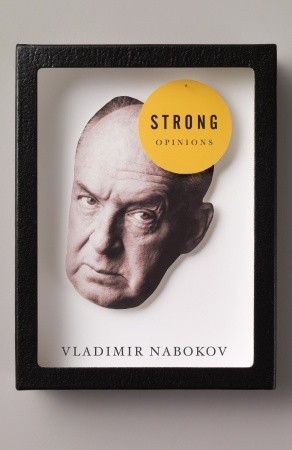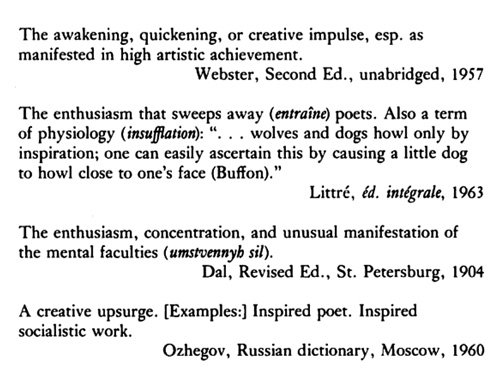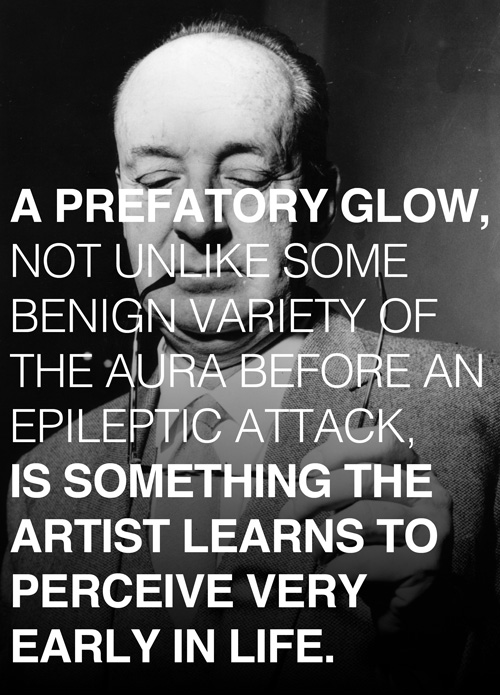Nabokov on Inspiration and the Six Short Stories Everyone Should Read
by Maria Popova“A prefatory glow, not unlike some benign variety of the aura before an epileptic attack, is something the artist learns to perceive very early in life.”
 “Show up, show up, show up,” Isabel
Allende advised, “and
after a while the muse shows up, too.” “Inspiration is for
amateurs,” Chuck
Close famously proclaimed, “the rest of us just show up and
get to work.” “When you
work regularly,”Gretchen
Rubin asserted, “inspiration strikes
regularly.” But as
prescriptive as we may get about the pursuit and attainment of inspiration, its
very nature remains ever-elusive.
“Show up, show up, show up,” Isabel
Allende advised, “and
after a while the muse shows up, too.” “Inspiration is for
amateurs,” Chuck
Close famously proclaimed, “the rest of us just show up and
get to work.” “When you
work regularly,”Gretchen
Rubin asserted, “inspiration strikes
regularly.” But as
prescriptive as we may get about the pursuit and attainment of inspiration, its
very nature remains ever-elusive.
That’s precisely what Vladimir Nabokovaddresses in an essay titled “Inspiration,” a fine addition to famous writers’ collected wisdom on writing,” originally published in theSaturday Review on November 20, 1972, and found in Strong Opinions (public library) — the same fantastic volume that gave us the author’s rare BBC interview on literature and life.
He begins with several dictionary definitions of the elusive grab-bag term:
Writing three decades after Rosamund Harding’s Anatomy of Inspiration and just eight years after Arthur Koetler’s cult-classic The Creative Act, Nabokov addresses the dismissive attitude many “serious” writers take toward the notion of inspiration — an attitude that E. B. White had expressed three years prior in his famous Paris Review interview, stating that “A writer who waits for ideal conditions under which to work will die without putting a word on paper.” But Nabokov challenges the assumption at the heart of such convictions:
A special study, which I do not plan to conduct, would reveal, probably, that inspiration is seldom dwelt upon nowadays even by the worst reviewers of our best prose. I say “our” and I say “prose” because I am thinking of American works of fiction, including my own stuff. It would seem that this reticence is somehow linked up with a sense of decorum. Conformists suspect that to speak of “inspiration” is as tasteless and old-fashioned as to stand up for the Ivory Tower. Yet inspiration exists as do towers and tusks.
He goes on to delineate a few types of inspiration, akin to Malcolm Cowley’s four stages of the creative process, and writes:
One can distinguish several types of inspiration, which intergrade, as all things do in this fluid and interesting world of ours, while yielding gracefully to a semblance of classification. A prefatory glow, not unlike some benign variety of the aura before an epileptic attack, is something the artist learns to perceive very early in life. This feeling of tickly well-being branches through him like the red and the blue in the picture of a skinned man under Circulation. As it spreads, it banishes all awareness of physical discomfort — youth’s toothache as well as the neuralgia of old age. The beauty of it is that, while completely intelligible (as if it were connected with a known gland or led to an expected climax), it has neither source nor object. It expands, glows, and subsides without revealing its secret. In the meantime, however, a window has opened, an auroral wind has blown, every exposed nerve has tingled. Presently all dissolves: the familiar worries are back and the eyebrow redescribes its arc
of pain; but the artist knows he is ready.A few days elapse. The next stage of inspiration is something ardently anticipated — and no longer anonymous. The shape of the new impact is indeed so definite that I am forced to relinquish metaphors and resort to specific terms. The narrator forefeels what he is going to tell. The forefeeling can be defined as an instant vision turning into rapid speech. If some instrument were to render this rare and delightful phenomenon, the image would come as a shimmer of exact details, and the verbal part as a tumble of merging words. The experienced writer immediately takes it down and, in the process of doing so, transforms what is little more than a running blur into gradually dawning sense, with epithets and sentence construction growing as clear and trim as they would be on the printed page.
He gives a reverse-engineered example from this own work, a beautiful passage he penned in 1965 that was the kernel for what would become his novel Ada, or Ardor. In describing it as the “first throb, the strange nucleus of the book that was to grow around it in the course of the next three years,” he argues that while the details and coloration may have changed, the “structural centrality” was preserved as the passage eventually made it into the novel. He then extrapolates:
[O]ne sees inspiration accompanying the author in his actual work on the new book. She accompanies him (for by now we are in the presence of a nubile muse) by means of successive flashes to which the writer may grow so accustomed that a sudden fizzle in the domestic illumination may strike him as an act of betrayal.
He goes on to tug at that quintessential writerly sanity-anchor, the daily routineor daily ritual:
One and the same person can compose parts of one and the same story or poem, either in his head or on paper, pencil or pen in hand (I am told there exist fantastic performers who actually type out their immediate product or, still more incredibly, dictate it, warm and bubbly, to a typist or to a machine!). Some prefer the bathtub to the study and the bed to the windy moor — the place does not matter much, it is the relationship between the brain and the hand that poses some odd problems.
Nabokov cites John Shade, the narrator in his 1962 novel Pale Fire:
“I am puzzled by the difference between two methods of composing: A, the kind which goes on solely in the poet’s mind, a testing of performing words, while he is soaping a third time one leg, and B, the other kind, much more decorous, when he’s in his study writing with a pen. In method B the hand supports the thought, the abstract battle is concretely fought. The pen stops in mid-air, then swoops to bar a canceled sunset or restore a star, and thus it physically guides the phrase toward faint daylight through the inky maze. But method A is agony! The brain is soon enclosed in a steel cap of pain. A muse in overalls directs the drill which grinds, and which no effort of the will can interrupt, while the automaton is taking off what he has just put on or walking briskly to the corner store to buy the paper he has read before. Why is it so? Is it, perhaps, because in penless work there is no pen-poised pause . . . Or is the process deeper, with no desk to prop the false and hoist the picturesque? For there are those mysterious moments when, too weary to delete, I drop my pen; I ambulate — and by some mute command the right word flutes and perches on my hand.”
He then affirms the notion that creativity is subtraction, echoing legendary French polymath Henri Poincare’s famous credo that “to invent is to choose and speaking to the essential role of editing, or filtering, inspiration:
This is, of course, where inspiration comes in. The words which on various occasions, during some fifty years of composing prose, I have put together and then canceled may have formed by now in the Realm of Rejection (a foggy but not quite unlikely land north of nowhere) a huge library of scrapped phrases, characterized and concorded only by their wanting the benison of inspiration.
This, he argues, is closely related to why great literature sings to us:
No wonder, then, that a writer who is not afraid to confess that he has known inspiration and can readily distinguish it from the froth of a fit, as well as from the humdrum comfort of the “right word,” should seek the bright trace of that thrill in the work of fellow authors. The bolt of inspiration strikes invariably: you observe the flash in this or that piece of great writing, be it a stretch of fine verse, or a passage in Joyce or Tolstoy, or a phrase in a short story, or a spurt of genius in the paper of a naturalist, of a scholar, or even in a book reviewer’s article. I have in view, naturally, not the hopeless hacks we all know — but people who are creative artists in their own right, such as, say, Trilling (with his critical opinions I am not concerned), or Thurber (e.g. in Voices of Revolution: “Art does not rush to the barricades”).
He goes on to reveal his personal system for categorizing and managing his reading diet — a system I, too, have been inadvertently and intuitively replicating for years in everything from the folders of my inbox to the labels of my RSS feed to the organization of my personal library:
Age is chary, but it is also forgetful, and in order to choose instantly what to reread on a night of Orphic thirst and what to reject for ever, I am careful to put an A, or a C, or a D-minus, against this or that item in the anthology. The profusion of high marks reconfirms me every time in the exhilarating belief that at the present time (say, for the last fifty years) the greatest short stories have been produced not in England, not in Russia, and certainly not in France, but in this country. Examples are the stained-glass windows of knowledge.
Nabokov concludes by offering six favorites from his A-list of stories (conspicuously authored by all-male authors) and “parenthesize[s] briefly the passage — or one of the passages — in which genuine afflation appears to be present, no matter how trivial the inspired detail may look to a dull criticule”:
- John Cheever’s “The Country Husband” (“Jupiter [a black retriever] crashed through the tomato vines with the remains of a felt hat in his mouth.” The story is really a miniature novel beautifully traced, so that the impression of there being a little too many things happening in it is completely redeemed by the satisfying coherence of its thematic interlacings.)
- John Updike’s “The Happiest I’ve Been” (“The important thing, rather than the subject, was the conversation itself, the quick agreements, the slow nods, the weave of different memories; it was like one of these Panama baskets shaped underwater around a worthless stone.” I like so many of Updike’s stories that it was difficult to choose one for demonstration and even more difficult to settle upon its most inspired bit.)
- J. D. Salinger’s “A Perfect Day for Bananafish”(“Stopping only to sink a foot in a soggy, collapsed castle . . .” This is a great story, too famous and fragile to be measured here by a casual conchometrist.)
- Herbert Gold’s “Death in Miami Beach” (“Finally we die, opposable thumbs and all.” Or to do even better justice to this admirable piece; “Barbados turtles as large as children . . . crucified like thieves . . . the tough leather of their skin does not disguise their present helplessness and pain.”)
- John Barth’s “Lost in the Funhouse” (“What is the story’s point? Ambrose is ill. He perspires in the dark passages; candied apples-on-a-stick, delicious-looking, disappointing to eat. Funhouses need men’s and ladies’ rooms at interval.” I had some trouble in pinning down what I needed amidst the lovely swift speckled imagery.)
- Delmore Schwartz’s “In Dreams Begin Responsibilities”(“. . . and the fatal merciless passionate ocean.” Although there are several other divine vibrations in this story that so miraculously blends an old cinema film with a personal past, the quoted phrase wins its citation for power and impeccable rhythm.)
Strong Opinions is a treasure trove in its entirety, delivering precisely what it promises on the tin — a lively time-capsule of Nabokov’s convictions on life, literature, culture, creativity, and beyond. Pair it with Nabokov on what makes a good reader.
Thanks, Natascha
Donating = Loving
Bringing you (ad-free) Brain Pickings takes hundreds of hours each month. If you find any joy and stimulation here, please consider becoming a Supporting Member with a recurring monthly donation of your choosing, between a cup of tea and a good dinner:

